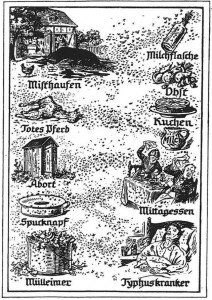
Mites and insects can transmit bacteria to people in two different ways: biologically and mechanically.
Biological transmission means that the mite or the insect plays a central role in the lifecycle of a micro-organism. The micro-organism must pass through the pest in order to evolve and the insect is the only possible way of transmission. It is especially bloodsucking insects that transfer diseases (malaria, yellow fever and Chagas disease etc.) biologically.
Mechanical transmission means that the insect is just one out of several transmission possibilities. The risk of insects transmitting diseases depend on their way of living. On this matter it makes sense to distinguish between actual food pests and those that do not exclusively live in foods. Food pests live in both unprocessed and processed food. Here they lay their eggs and live their whole lives. These insects rarely act as transmitters of diseases. That includes mites, granary weevils, saw-toothed grain beetles and moths.
Insects that do not exclusively live in foods are mobile and have the potential to transmit diseases to foods from trash, excrements, dead animals, sewerage and even from sick people and animals. Among the mobile pests are cockroaches, silver fish, pharaoh ants, booklice, flies and wasps. Mice, rats and birds are also members of the mobile pests group.
Among the more than 100 different kinds of viruses, bacteria, single-celled micro-organisms and eggs of parasitic worms that is found in house flies and cockroaches have isolated several of the types that can cause serious diseases such as dysentery, typhoid, polio and tuberculosis. Micro-organisms exist on the outside of the insects, on hair and mouth etc., but here they normally only survive a few hours. House flies, cockroaches and ants may also obtain micro-organisms when they eat. In the intestines of the insects, many of the micro-organisms survive for days and then later on they are transmitted through the insects’ excrements.
It is very difficult and in specific cases not even possible to estimate the role of insects and other food pests in relation to transmission. Because of the potential risk insects always present, they should not be tolerated near food that will not later be heat treated or otherwise secured against micro-organisms and places with a risk of toxin production. Pests in companies or kitchens are usually taken as a sign of low quality hygiene. This is probably true in most cases. A study in Canada showed that there is a connection between poor cleaning in workplaces and the number of pests and microbes in the finished product. This is not necessarily a direct connection. It can also be the consequence of general company hygiene.




